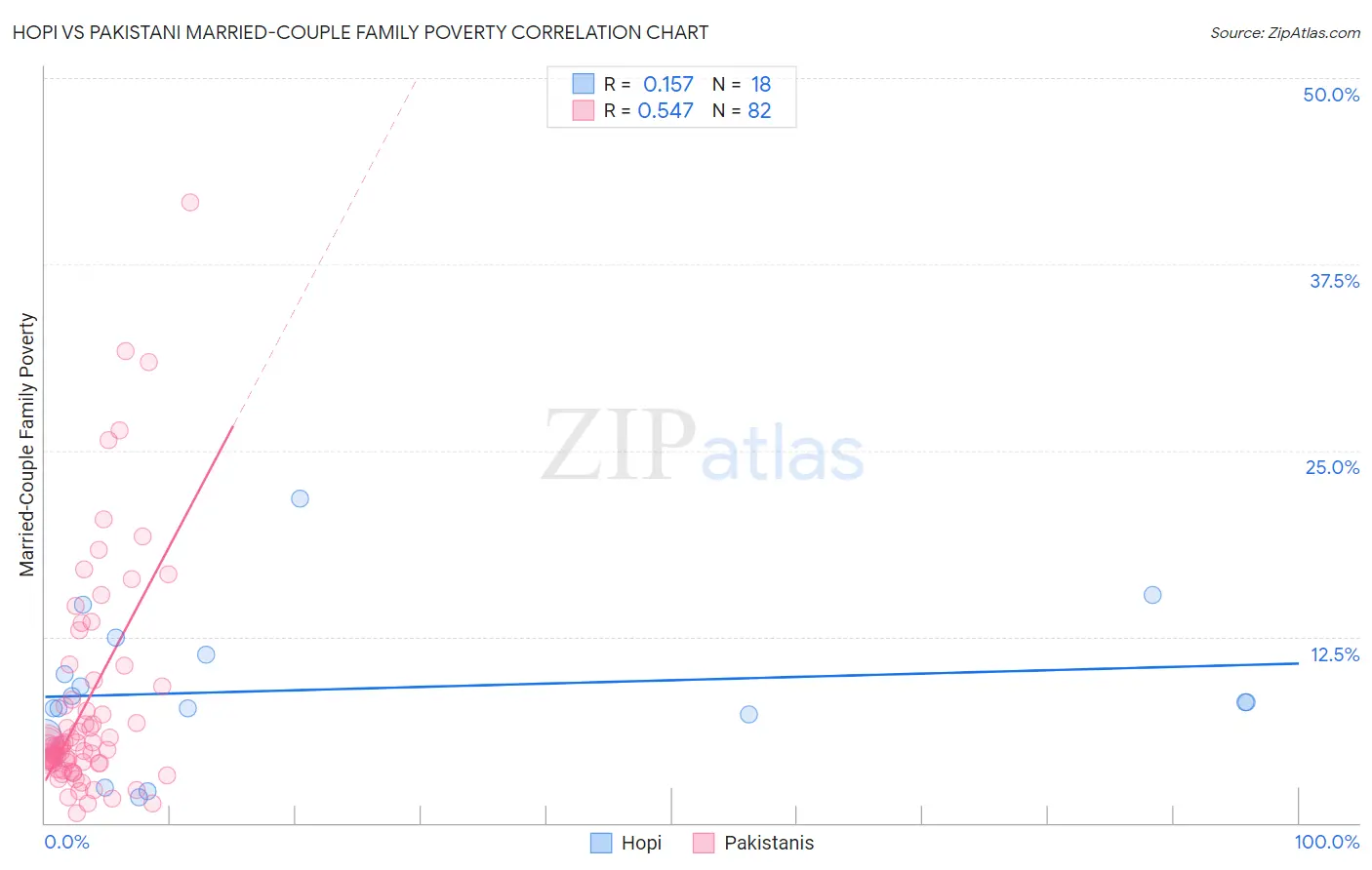Hopi vs Pakistani Married-Couple Family Poverty
COMPARE
Hopi
Pakistani
Married-Couple Family Poverty
Married-Couple Family Poverty Comparison
Hopi
Pakistanis
7.1%
MARRIED-COUPLE FAMILY POVERTY
0.0/ 100
METRIC RATING
309th/ 347
METRIC RANK
4.7%
MARRIED-COUPLE FAMILY POVERTY
96.2/ 100
METRIC RATING
111th/ 347
METRIC RANK
Hopi vs Pakistani Married-Couple Family Poverty Correlation Chart
The statistical analysis conducted on geographies consisting of 74,623,640 people shows a poor positive correlation between the proportion of Hopi and poverty level among married-couple families in the United States with a correlation coefficient (R) of 0.157 and weighted average of 7.1%. Similarly, the statistical analysis conducted on geographies consisting of 333,416,483 people shows a substantial positive correlation between the proportion of Pakistanis and poverty level among married-couple families in the United States with a correlation coefficient (R) of 0.547 and weighted average of 4.7%, a difference of 49.9%.

Married-Couple Family Poverty Correlation Summary
| Measurement | Hopi | Pakistani |
| Minimum | 1.7% | 0.63% |
| Maximum | 21.7% | 41.7% |
| Range | 20.0% | 41.0% |
| Mean | 9.0% | 7.9% |
| Median | 8.1% | 5.2% |
| Interquartile 25% (IQ1) | 7.3% | 4.0% |
| Interquartile 75% (IQ3) | 11.3% | 8.3% |
| Interquartile Range (IQR) | 4.0% | 4.3% |
| Standard Deviation (Sample) | 5.0% | 7.6% |
| Standard Deviation (Population) | 4.8% | 7.5% |
Similar Demographics by Married-Couple Family Poverty
Demographics Similar to Hopi by Married-Couple Family Poverty
In terms of married-couple family poverty, the demographic groups most similar to Hopi are Immigrants from Nicaragua (7.1%, a difference of 0.030%), Immigrants from Dominica (7.1%, a difference of 0.080%), Immigrants from Armenia (7.1%, a difference of 0.080%), Immigrants from St. Vincent and the Grenadines (7.1%, a difference of 0.19%), and British West Indian (7.1%, a difference of 0.49%).
| Demographics | Rating | Rank | Married-Couple Family Poverty |
| Immigrants | Ecuador | 0.0 /100 | #302 | Tragic 6.7% |
| Immigrants | El Salvador | 0.0 /100 | #303 | Tragic 6.8% |
| Cubans | 0.0 /100 | #304 | Tragic 6.8% |
| Haitians | 0.0 /100 | #305 | Tragic 6.8% |
| Immigrants | Haiti | 0.0 /100 | #306 | Tragic 7.0% |
| Guatemalans | 0.0 /100 | #307 | Tragic 7.0% |
| Spanish American Indians | 0.0 /100 | #308 | Tragic 7.1% |
| Hopi | 0.0 /100 | #309 | Tragic 7.1% |
| Immigrants | Nicaragua | 0.0 /100 | #310 | Tragic 7.1% |
| Immigrants | Dominica | 0.0 /100 | #311 | Tragic 7.1% |
| Immigrants | Armenia | 0.0 /100 | #312 | Tragic 7.1% |
| Immigrants | St. Vincent and the Grenadines | 0.0 /100 | #313 | Tragic 7.1% |
| British West Indians | 0.0 /100 | #314 | Tragic 7.1% |
| Inupiat | 0.0 /100 | #315 | Tragic 7.1% |
| Hondurans | 0.0 /100 | #316 | Tragic 7.2% |
Demographics Similar to Pakistanis by Married-Couple Family Poverty
In terms of married-couple family poverty, the demographic groups most similar to Pakistanis are Immigrants from Bolivia (4.7%, a difference of 0.040%), Tongan (4.7%, a difference of 0.18%), Immigrants from Hong Kong (4.7%, a difference of 0.20%), Immigrants from Nepal (4.7%, a difference of 0.25%), and Laotian (4.7%, a difference of 0.40%).
| Demographics | Rating | Rank | Married-Couple Family Poverty |
| Immigrants | Moldova | 97.1 /100 | #104 | Exceptional 4.7% |
| Aleuts | 97.0 /100 | #105 | Exceptional 4.7% |
| Immigrants | France | 96.9 /100 | #106 | Exceptional 4.7% |
| Immigrants | Germany | 96.8 /100 | #107 | Exceptional 4.7% |
| Laotians | 96.6 /100 | #108 | Exceptional 4.7% |
| Immigrants | Hong Kong | 96.4 /100 | #109 | Exceptional 4.7% |
| Immigrants | Bolivia | 96.2 /100 | #110 | Exceptional 4.7% |
| Pakistanis | 96.2 /100 | #111 | Exceptional 4.7% |
| Tongans | 95.9 /100 | #112 | Exceptional 4.7% |
| Immigrants | Nepal | 95.9 /100 | #113 | Exceptional 4.7% |
| Immigrants | Indonesia | 95.1 /100 | #114 | Exceptional 4.8% |
| Taiwanese | 94.8 /100 | #115 | Exceptional 4.8% |
| Celtics | 94.8 /100 | #116 | Exceptional 4.8% |
| Kenyans | 94.7 /100 | #117 | Exceptional 4.8% |
| Immigrants | Philippines | 94.6 /100 | #118 | Exceptional 4.8% |